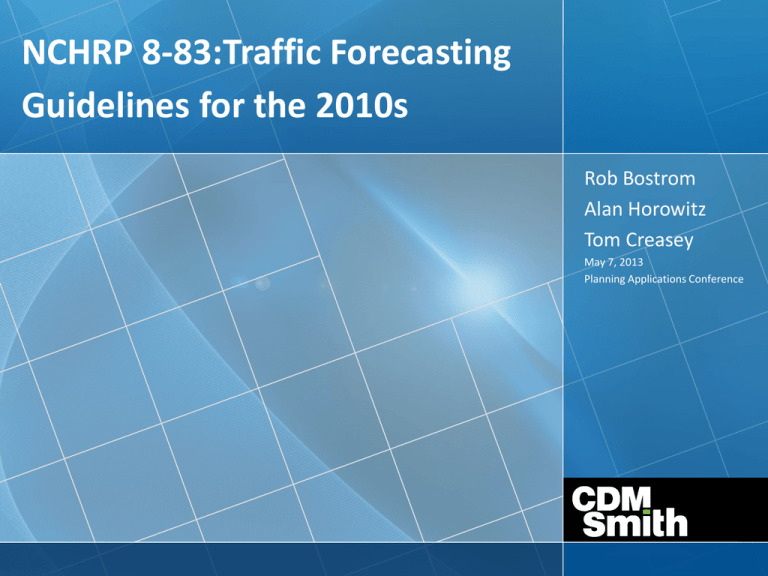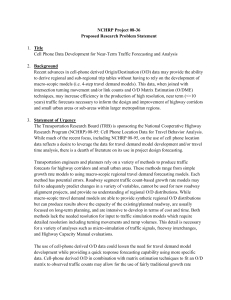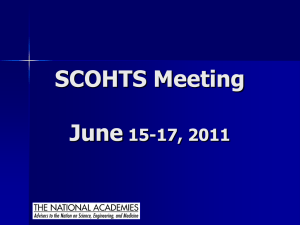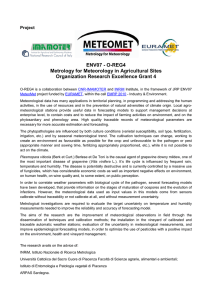NCHRP 8-83 Scope - 15th TRB National Transportation Planning
advertisement

NCHRP 8-83:Traffic Forecasting Guidelines for the 2010s Rob Bostrom Alan Horowitz Tom Creasey May 7, 2013 Planning Applications Conference Presentation Overview • NCHRP 8-83 Project Background • Deliverables – Interim Report – Draft Final Report • What’s Next? Project Background • Need – Produce traffic forecasts for design, planning and operational project analysis – Models and other tools produce results that need smoothing or factoring – NCHRP 255 used since 1982 refining traffic forecasts • NCHRP 8-83 – Started in March, 2011 – Due to be finished at end of July Project Background • Program Manager: Nanda Srinivasan • Team – – – – – CDM Smith: Rob Bostrom, Principal Investigator Alan Horowitz of University of Wisconsin at Milwaukee Tom Creasey of Stantec Ram Pendyala of Arizona State University Mei Chen of University of Kentucky • Panel – Chair: Mike Bruff of NC DOT – Sarah Sun, Kermit Wies, Eric Pihl, Robert Winnick, Doug Laird, Jeff Shelton, Subrat Mahapatra, Derek Miura, Matthew Hardy, Phillip Cox, Dan Lamers NCHRP 8-83 Scope Task 1: Prepare a detailed plan to conduct a review of project-level forecasting procedures Task 2: Prepare a technical memo that synthesizes current use and facilitates implementation of subsequent tasks Task 3: Conduct a critical and informed review of NCHRP 255 to identify methods and tools to be included in the Guidebook Task 4: Prepare an Interim Report NCHRP 8-83 Scope Task 5 - Develop/Document Methods and Tools for Project-Level Analysis in Addition to Those Contained in NCHRP 255 Task 6 - Improvements to Traditional Models Task 7 - Review Advanced Techniques Task 8 – Prepare the Guidebook with an Executive Summary Deliverables • Interim Draft Report – Covers tasks 1-4 of work plan and submitted on 1/20/12 – Sections: • • • • Traffic forecasting state-of-the-practice Traffic forecasting process, tools and methodologies NCHRP Report 255 review and other tools/methodologies Appendices • Final Draft Report – – – – 11 chapters, 11 appendices, 400 pages and counting Includes interim report contents Web contents 6 case studies Interim Report: Traffic Forecasting Stateof-the Practice • • • • Source Documents Survey Expert Panel Traffic forecasting process review – Process, users, policy/complexity, result communication • Travel forecasting model ideal – blended TDM/microsimulation • Travel forecasting models – 4-step; 4-step enhancements; advanced modeling • Model data inputs/outputs Interim Report: NCHRP 255 Review Interim Report: NCHRP 255 Review Interim Report: Other Tools & Methodologies • Non-modeling tools – – – – – – – Manual gravity procedure (KYTC) NCHRP 255 spreadsheets Turning movement tools OD matrix growth factoring Time series models Traffic impact study tools Elasticity methods Interim Report: Appendices • • • • Source documents Survey Questionnaire Expert Team Comments Road Map Interim Report: Appendices Final Draft Report: Chapter 1 Introduction • What are projects? • History/context/significance of NCHRP 255 • Chapter by chapter review of NCHRP 255 • Survey and source documents • Traffic forecasting guidelines • Organization of report Chapter 2: Fundamental Traffic Forecasting Overview • Traffic forecasting parameters and source data - e.g. ADT, DHV • Traffic forecasting tools - TDMs and more • Measures of effectiveness - see graphic • Essential bookshelf – must reads for forecasters Chapter 3: Overview of Traffic Forecasting Tools and Methodologies • • • • • • • The travel forecasting model ideal State-of-the-practice travel forecasting models SOP of data inputs for travel forecasting models SOP of outputs for travel forecasting models Defaults vs. locally specific parameters Other traffic forecasting tools and methodologies Travel demand model computational issues Chapter 4: Project Level Forecasting Process • Traffic forecasting context • Traffic forecasting steps • Key Traffic Forecasting Considerations – Accuracy – Judgment – Traffic forecasting rules of thumb Chapter 5: Work with a Travel Model • Understanding your model • Validation methods and standards • Errors and variability in speed and volume data • Fixing issues in input or validation data • Understanding travel model outputs • Dealing with outliers in model outputs Chapter 5: Work with a Travel Model • Default free flow travel times for a TDM: Chapter 6: Model Output Refinements • • • • • Screenline refinement and base volumes Refining turning movement outputs of travel models Refining directional splits from travel models Refining speed and travel time outputs of travel models Model refinement with origin-destination matrix estimation Chapter 7: Increasing spatial detail of traffic models • Focusing: enhancing detail in regional or statewide models • Windowing (subarea model) • Custom subarea focused models • Multi-resolution modeling systems • Hybrid models • Refining E-E trip tables • Case studies Chapter 8: Improving temporal accuracy of traffic forecasts • • • • • • • • • Activity and tour-based model systems Dynamic traffic assignment Peak spreading Pre-assignment factoring Post-assignment factoring Day of week Month of year Vehicle class considerations Case studies Chapter 8: Pre-assignment table (NCHRP 716) Chapter 8: Post-assignment table • Hourly factors derived from ATRs for post-assignment ADT processing. • Categories: urban area small/medium/large, rural area; ½ of table below Chapter 9: Traffic Forecasting Methods for Special Purpose Applications • Basic forecasts w/ ADT, DHV and turning movements • Data extrapolations • Vehicle mix & MOVES • ESALs • Benefit-cost analysis • Toll/revenue forecasts • Work zone congestion • Incident management • Non-recurring congestion • Environmental justice • Traffic impact studies • Case studies Chapter 10: Tools Outside of Travel Models • When to use non-TDM methods • Time series of traffic volume data • Sketch planning and spreadsheet techniques • Elasticity methods • Post processing using HCM 2010 • Stitching a model together • Case studies Chapter 11: Case Studies • Arterial network • Network window • Small city (Charleston, SC) • Large City (Atlanta) • Time series on a link • Multi-resolution modeling (Phoenix) Appendices • • • • Glossary/acronyms Survey/expert panel/NCHRP 255 detailed review Modeling source documents Examples – – – – Traffic forecasting Trend line analysis Turning movement Model spreadsheet • Modeling checklist Recommendations • Project-level forecasting, for the most part, use travel models and/or time series. • Many traffic forecasts for projects need some sort of refinement. – Ratios/deltas – ODME • Lots of judgment allowed/required. What’s Next? • • • • Draft Final Report – June 17th Final Report – July 31st Publication – end of year Web content – Spreadsheet demos – Methodologies • Training – after publication • ADB45 – Traffic forecasting Wiki • Questions/comments?










